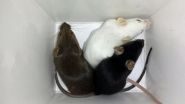(Press-News.org) OAK BROOK, Ill. - Radiologists from the National Institutes of Health (NIH) and Emory University School of Medicine have issued a special report on radiology preparedness for handling cases of Ebola virus. The report, outlining their protocols and recommendations, is published in the online edition of the journal Radiology.
Healthcare administrators are placing a major emphasis on Ebola preparedness training at medical facilities throughout the U.S. Failure to have proper procedures in place to diagnose and treat patients with Ebola virus was cited as a major reason for infection of medical personnel in Dallas.
"Clear and frequent communication with the healthcare staff is essential during this time of heightened public concern and understandable caution," said report co-author Carolyn C. Meltzer, M.D., from the Departments of Radiology and Imaging Sciences, Psychiatry and Behavioral Sciences, and Neurology at Emory University School of Medicine in Atlanta. "For example, at Emory University Hospital, open Town Hall information sessions, the wide dissemination of standardized screening protocols, and close intra- and interdepartmental communication have supported a safe environment in caring for patients with Ebola virus."
In the U.S., there are currently four biocontainment facilities with specialized isolation rooms and staff trained to treat patients with Ebola virus: Emory University Hospital in Atlanta, NIH Clinical Center in Bethesda, Md., St. Patrick Hospital in Missoula, Mont., and Nebraska Medical Center in Omaha. Additional tertiary care institutions have been preparing staff and facilities to handle patients with Ebola virus.
"Medical imaging does not provide diagnosis of Ebola virus disease, but patient assessment in the emergency department and treatment isolation care unit is likely to require imaging services," said the report's co-author, David A. Bluemke, M.D, Ph.D., director of the Department of Radiology and Imaging Sciences at the NIH Clinical Center.
At present, the role of medical imaging
in Ebola care is to exclude other diagnoses or assess complications of the virus. For the radiology team to provide the best possible medical care for the patient while maintaining full protection of the medical staff, medical imaging exams of patients with Ebola virus should be performed within a specialized isolation unit.
Portable X-ray units and bedside ultrasound imaging have been used in biocontainment units. At the NIH, training sessions for the radiology staff directly involved in Ebola patient care involves in-depth information on the background and spread of the virus, as well as isolation unit procedures.
Radiology departments must develop standard operating procedures for performing imaging procedures in an isolation unit. Details of the standard operating procedure will vary, depending on the type of equipment available, whether the facility is equipped for wired or wireless image transmission, and complexity of the examination.
Currently, two different strategies exist. In the first, the radiologic technologists do not enter the patient's room, known as the Hot room. In this approach, medical technologists instead stay in the Warm room (anteroom) and provide verbal instructions for equipment use to nurses or physicians in the Hot room. In the second approach, radiologic technologists enter the Hot room to assist in operation of the imaging equipment. This approach is needed when the equipment may be somewhat more complex.
The authors emphasize that every effort should be made to perform general X-ray procedures in the isolation room rather than transporting the patient to the radiology department.
Preparation for procedures in the Hot room includes ensuring that all supplies are in place (including lead aprons, equipment disinfectant/wipes and equipment covers) and batteries in the portable equipment are fully charged. The X-ray detector is then double bagged and each bag is separately zip-locked prior to entering the patient's room.
During the procedure, close cooperation between the isolation unit nurse and the radiologic technologist is necessary.
Transporting a patient with Ebola virus to the radiology department for a medical imaging procedure is not advisable and requires additional precautions. For example, the patient transportation route must be coordinated with the hospital's infection control team.
In addition, disinfection of radiology procedure rooms requires many hours and may prohibit diagnostic treatment of other patients in the facility. CT and MRI equipment are not designed for imaging of patients with Ebola or other highly contagious diseases. Small crevices in the gantry table and moving parts are extremely difficult to protect with plastic covers, and bodily fluids can accumulate in narrow recesses that are inaccessible to surface cleaning.
"Radiology staff directly involved in the care of patients with Ebola virus disease need to be identified and educated regarding procedures of the isolation unit and regarding appropriate donning and doffing of correctly-sized personal protective equipment," Dr. Bluemke said. "Open and frequent communications are essential."
INFORMATION:
"Ebola Virus Disease: Radiology Preparedness." Note: The views expressed in this report are those of the authors and do not necessarily represent the opinion of the National Institutes of Health, Department of Health and Human Services, or the Federal Government.
Radiology is edited by Herbert Y. Kressel, M.D., Harvard Medical School, Boston, Mass., and owned and published by the Radiological Society of North America, Inc. (http://radiology.rsna.org/)
RSNA is an association of more than 54,000 radiologists, radiation oncologists, medical physicists and related scientists promoting excellence in patient care and health care delivery through education, research and technologic innovation. The Society is based in Oak Brook, Ill. (RSNA.org)
New federal regulations requiring school meals to contain more whole grains, less saturated fat and more fruits and vegetables, while perhaps improving some aspects of the food being served at schools across the United States, may also be perpetuating eating habits linked to obesity, diabetes and other diet-related diseases, an analysis by Johns Hopkins Bloomberg School of Public Health researchers has found.
The reasons: Based on analysis of school meals and the new requirements, the whole grains served are mostly processed, which means they are converted into sugar ...
NEW ORLEANS (Nov. 18, 2014) - Researchers from Drexel University in Philadelphia will present research on a wide range of public health topics emphasizing urban health challenges, geographic methods in public health, community resilience and more, at the 142nd annual meeting and exposition of the American Public Health Association Nov. 15-19.
A few selected highlights among the dozens of posters and presentations by faculty, staff and students from the Drexel University School of Public Health include:
What Makes Communities Resilient in Times of Adversity?
Psychologists ...
Early sodium supplementation for very premature infants can enhance weight gain according to a recent study by researchers at the University of Cincinnati Medical Center and Cincinnati Children's Hospital Medical Center.
The results of the study, published today in the OnlineFirst version of the Journal of Parenteral and Enteral Nutrition (JPEN), the research journal of the American Society for Parenteral and Enteral Nutrition (A.S.P.E.N.), examined 53 infants during the first months of life who had been born at less than 32 weeks of pregnancy.
Poor growth of premature ...
Researchers at Indiana University-Purdue University Indianapolis say acculturative stress may explain, in part, why Indiana's Latino youth face an alarming disparity in depression and suicide rates when compared to their white counterparts.
While examining epidemiological health disparities data, a team of researchers led by Silvia Bigatti at the Richard M. Fairbanks School of Public Health noticed that Latino teens in Indiana had a 65 percent higher rate of suicide attempts and a 24 percent higher rate of depression than white teens.
"When we saw the alarming disparity ...
Promoting and maintaining financial fraud whistleblower programs, such as those of the Securities and Exchange Commission (SEC) and the Commodity Futures Trading Commission (CFTC), is costly.
Cases involving whistleblowers require significant resources as they take nearly 10 months longer to complete. Rewards for whistleblowers who come forward with original information leading to an enforcement action can be large, ranging from 10% to 30% of monetary sanctions over $1 million. This past September, the SEC awarded $30 million to a whistleblower--it's largest award yet. ...
Researchers are studying the Caulobacter crescentus bacterium because of its developmental process and cellular cycle, which serve as models for a number of pathogenic bacteria. They all have in common the use of polysaccharides to create a particularly effective protective envelope, or capsule. Professor Viollier's laboratory at the University of Geneva's (UNIGE) Faculty of Medicine has just unraveled the secrets of capsule formation during the cellular cycle and perhaps even identified potential Achilles' heel of bacteria. These results were published in the last edition ...
SALT LAKE CITY, Nov. 18, 2014 - When a viral infection spread through five genetically identical mice in a row, the virus replicated faster and became more virulent or severe. But when the infection spread one-by-one through five genetically diverse mice, the virus had trouble adapting and became less virulent.
By showing this long-suspected mechanism holds true within a single species of vertebrate animal, namely, mice, the University of Utah study suggests that increased genetic diversity should be promoted in livestock and in captive-bred endangered species so as to ...
This news release is available in French. There is no significant difference in the prevalence of verbal abuse in the workplace between men and women, according to a systematic review of the literature conducted by researchers at the Institut universitaire de santé mentale de Montréal and the University of Montreal.
Verbal abuse is the most common form of workplace violence. It can lead to many consequences, particularly at the psychological and organizational levels. Several studies underline the importance of taking into account sociodemographic variables ...
Ewing sarcoma is a cancer of bone or its surrounding soft tissue that primarily affects children and young adults. A hallmark of Ewing sarcoma is a translocation event that results in the fusion of an RNA binding protein, known as EWS, with a transcription factor, such as FLI1. Previous work suggested that the fusion protein EWS-FLI1 promoted cancer by changing gene expression; however, the gene targets were unknown. A new study in the Journal of Clinical Investigation indicates that a long noncoding RNA named Ewing sarcoma-associated transcript 1 (EWSAT1) is a critical ...
Atherosclerosis is a leading cause of heart attacks and stroke. The narrowing of blood vessels that is caused by atherosclerosis can be treated with angioplasty or stenting to improve blood flow. However, the stenting process induces deleterious remodeling of the blood vessel that can increase thrombosis risk, limiting the use of this strategy. In an article published in the Journal of Clinical Investigation, a research team led by Ziad Ali of the Columbia University Medical Center now provides new insights into the pathological remodeling that occurs following blood ...

